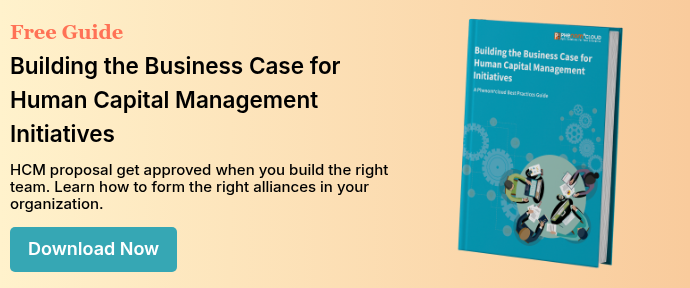
In our previous article, we discussed the need to influence decision-makers and the need to form alliances when you are preparing a business case for a human capital initiative. Today’s article is about building the business case for your proposal. The first step is to frame the business need.
Define the Business Need
In Part 1 of this series, we discussed the need to form alliances with operational business leaders who may have a problem we can help solve. Here are a few simple examples.
- We are losing people to our competitor.
- Unplanned absences are disrupting production.
- We don’t know who are high potential employees are.
- People on the sales floor are not cross-selling.
- We can’t find qualified technicians.
Define the need and frame it in terms of your business strategy. Identify the related key performance indicators (KPIs). You will need to gain the support of the person accountable for the KPIs.
Assemble the Team
Your project team should be a small, efficient team of experts:
Finance. Ask your CFO to designate a representative to guide your team in financial strategy, cost/benefit analysis, forecasting, and ROI calculations.
Line of Business. This is an expert in the corporate entity that owns the KPI. It may be experts in sales, production, research, human resources, logistics, or any other function. It may also include other people affected by your proposal.
Marketing or Customer Service. If the problem and solution affect customers, you will need an expert who knows them and their needs.
Technology. Expertise in this area could include external entities, such as vendors or consultants.
Analytics. Include your human capital analytics team if you have one. If you don’t, you may be able to use analytical capability in marketing or finance. You may need an analytics consultant. (Or this may be the opportunity you need to develop a business case for human capital analytics.)
Project Management. A project manager will provide expertise on how to analyze and present your proposed activities and manage your resources.
Analyze the Business Need
Use the expertise on your team to explore why the business need or problem exists. Your organization may use Six Sigma or other disciplines to guide your analysis.
Some of the information you need will be in functions other than Human Resources. You may need to correlate sales, revenue, production or logistics data with candidate or employee profiles, learning assessments, or demographic and population data. Work with the owners of the data to gain access.
If you are dealing with a process, develop a flow diagram or flowchart to analyze it. Use cause-effect diagrams and interrelationship digraphs to establish relationships and root causes.
Document your analysis. You will need to explain how you arrived at your conclusions.
Evaluate Options
Use group brainstorming to generate potential solutions. You have team members from several disciplines, and each will have a different point of view. Bone up on your brainstorming techniques so you get a free flow of ideas.
Frame proposed solutions as hypotheses: If we do this, then this will happen. The best place to start might be your null hypothesis, i.e., what happens if we do nothing? Define business results – costs, revenue, market share. You will need to discuss your null hypothesis when you ask for approval.
If we do nothing, unplanned absences will continue to impact production. To meet our commitments, we will need to over-staff by 11% with additional employees and overtime. Our production costs will increase by 7%, and net profit will fall by 4%.
Use analytical models to test your hypotheses, if you can. If not, let your Finance representative guide your analysis.
Evaluate and compare your ideas. For each one, compare cost, revenue, risk, and time to implement. Eliminate or modify proposed solutions that are unfeasible, unacceptable, or not aligned with the business strategy.
Work with your executive sponsor to identify which proposals have the best chance of being approved by your executive team.[1]
Narrow your list down to the best two or three alternatives, and create a high-level plan for each.
High-Level Plan
The purpose of the high-level plan is to understand the resources required and develop a rough idea of the costs and benefits. It is the who, what, where, when, and how of your proposal.
The who is critical at this point because you will need the buy-in and support of the people involved, especially the people who will do the work or provide funding.
To construct the high-level plan, list the major activities and milestones in chronological order. For each activity, list who will do what, where, when and how. If you need help, work with your project management expert.
Next Steps
In our next article, we will discuss how to construct the financial impact of your proposals and how you will present the numbers to your reviewers. Your Finance expert will be your guide.
References :
[1] Sheen, Raymond. HBR Guide to Building Your Business Case. Harvard Business Review Press.
PhenomᵉCloud is a full-service technology company dedicated to helping clients solve business problems, improve the capability of their people, and achieve better results.


Leave a Comment